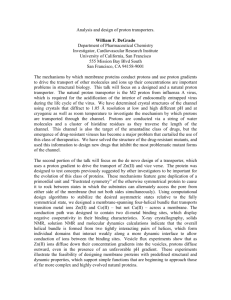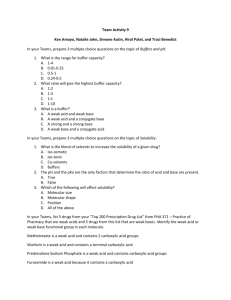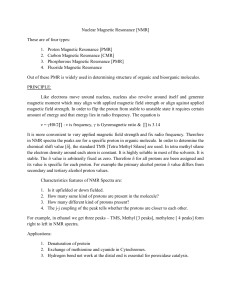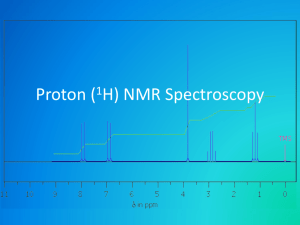File - Dr Howe's Chemistry website
advertisement
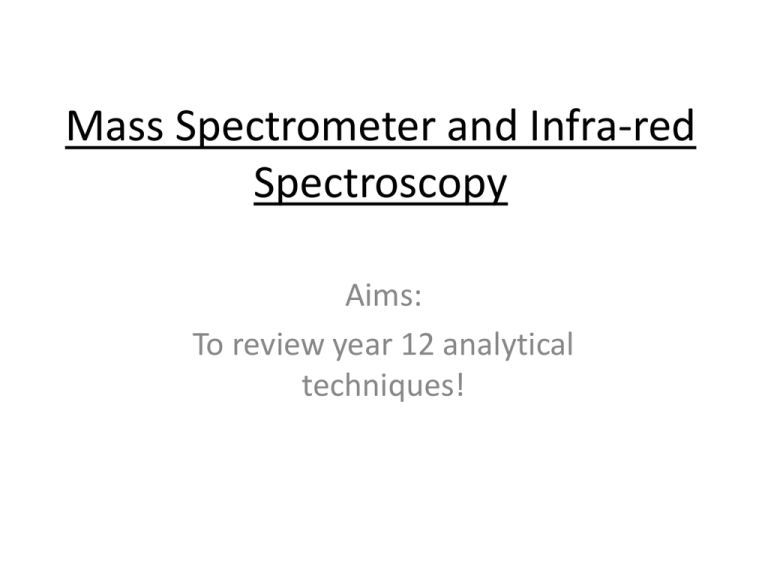
Mass Spectrometer and Infra-red Spectroscopy Aims: To review year 12 analytical techniques! What do we use the mass spectrometer for and how does it work? What is it used for? • To identify unknown compounds • To determine the abundance of each isotope in an element • To gain information about the structure and properties of molecules How it works The sample is first Vapourised. Then it is Ionised by having high energy electrons fired at it. M(g) + e- → M+(g) + 2e- VIA These ions are then Accelerated by a strong electric field How it works A good vacuum is essential in the whole of the apparatus How it works The accelerated ions are Deflected by the magnetic field, bigger ions are deflected less. The ion beams can be focused on the Detector We can use the mass spectrometer to work out the Ar of a sample containing different isotopes. Antimony has two isotopes 121-Sb and 123Sb. In a bullet at a crime scene there was a sample of antimony containing 57.3% 121-Sb and 42.7% 123-Sb. Calculate the relative atomic mass of the sample of antimony from the bullet. Identifying organic compounds • Organic molecules do not hold charge well. • The ions break up or fragment. • They break into smaller ions and neutral fragments. • They do this in regular patterns. i.e. the same molecule always fragments in the same way. • This allows us to analyse them. Fragmentation • M(g) + e- → M+(g) + 2e• M+ is called the molecular ion, M+. Since M+ has lost an electron, it is less strongly held together than the original molecule. So, some of the molecular ions fall apart (fragment) in the ion source to give fragment ions (F+) and neutral fragments (N). • M+(g) → F+(g) + N*(g) • Analysis of the charged particles in the mass spectrometer gives the MASS SPECTRUM of the molecule. Mass Spectrum of ethanol Molecular ion: tells you the molecular mass of the whole compound. Mass Spectrum of ethanol: Identify the fragments responsible for the following peaks: 46 45 31 29 15 Possible fragments + + 45 31 M+ + 46 ++ 29 + + 15 Mass Spectrum of an alcohol. Identify the alcohol and draw structures for the fragment ions represented by the peaks at: 60, 59, 43, 31 and 29. Possible fragments + + 59 31 M+ + 60 + + 43 + + 29 IR spectroscopy What do you remember? How IR spectroscopy works… •Shine a range of IR frequencies, one at a time through a sample of organic compound and at some of the frequencies the energy will be absorbed. •A detector on the other side of the sample would show that some frequencies are absorbed whilst others are not. • If a particular frequency is being absorbed as it passes through the compound being investigated, it must mean that its energy is being transferred to the compound. • Energies in infra-red radiation correspond to the energies involved in bond vibrations. Bend and Stretch • In covalent bonds, atoms aren't joined by rigid links; • the two atoms are held together because both nuclei are attracted to the same pair of electrons. • The two nuclei can vibrate backwards and forwards - towards and away from each other - around an average position. All molecules absorb infrared radiation; absorbing energy makes the bonds vibrate. STRETCHING BENDING Every bond vibrates at its own frequency, dependant upon bond strength, bond length and the mass of atoms involved in bond. Fingerprint regions • You must be able to identify the following peaks. – C-H in alkanes/alkenes/aldehydes – O-H in alcohols/carboxylic acids – N-H in amines – C=O in aldehydes and ketones – C-X in halogenoalkanes • You will have data books in exam, if required. http://www.rsc.org/learnchemistry/resource/res00000059/in fra-red-spectrometer C-O in alcohols, esters & carboxylic acids 1000-1300 C=O in aldehydes and ketones 1640-1750 C-H in alkanes/alkenes/aldehydes 2850-3100 O-H in carboxylic acids 2500-3300 (very broad) N-H in amines/amides 3200-3500 O-H in alcohols/carboxylic acids 3200-3550 (broad) C-O in alcohols, esters & carboxylic acids 1000-1300 C=O in aldehydes, ketones & carboxylic acid 1640-1750 C-H in alkanes/alkenes/aldehydes 2850-3100 O-H in carboxylic acids 2500-3300 (very broad) N-H in amines/amides 3200-3500 O-H in alcohols/carboxylic acids 3200-3550 (broad) C-O in alcohols, esters & carboxylic acids 1000-1300 C=O in aldehydes and ketones 1640-1750 C-H in alkanes/alkenes/aldehydes 2850-3100 O-H in carboxylic acids 2500-3300 (very broad) N-H in amines/amides 3200-3500 O-H in alcohols/carboxylic acids 3200-3550 (broad) C-O in alcohols, esters & carboxylic acids 1000-1300 C=O in aldehydes, ketones & carboxylic acids 1640-1750 C-H in alkanes/alkenes/aldehydes 2850-3100 O-H in carboxylic acids 2500-3300 (very broad) N-H in amines/amides 3200-3500 O-H in alcohols/carboxylic acids 3200-3550 (broad) Lesson 2 Nuclear Magnetic Resonance Used to study molecular structures in detail. NMR relies on the fact that protons and neutrons have a property called spin and can be in one of two opposite directions. In the nucleus opposite spins pair up and cancel out. Some nuclei have odd numbers of nucleons. This produces a small net nuclear spin which generates a small magnetic field. Nuclei with an overall spin can be thought of as tiny magnets. They line up in a strong magnetic field and are either with the field or opposed to it. Nuclei that oppose the magnetic field have a higher energy than those that align. This creates an energy gap. Resonance A nucleus in the low spin state can be ‘excited’ to the upper spin state by providing energy that matches the energy gap. This is done by applying low-energy radiofrequency waves. Resonance A nucleus in the low spin state can be ‘excited’ to the upper spin state by providing energy that matches the energy gap. This is done by applying low-energy radiofrequency waves. The excited nucleus will drop back down to its low-energy state emitting the same amount of energy: this is called relaxation. The cycle of resonance continues as long as the frequency of radiation supplied matches exactly the energy gap. The magnetic field felt by a nucleus depends on 2 factors 1) The applied strong magnetic field 2) Weaker magnetic fields from electrons surrounding the nucleus and in surrounding atoms. These electrons have a shielding effect. Different environments result in different resonance frequencies and so different chemical shifts– this can give us clues about the structure of a molecule. Chemical shift Chemical shift, δ = place in NMR spectrum at which a nucleus absorbs energy. Measured in parts per million and is measured relative to a reference signal from a standard compound – tetramethylsilane or TMS. TMS has 12 equivalent protons and gives a sharp signal that is easy to identify. The chemical shift of TMS is defined as δ=0 Solvents The sample is dissolved in a deuterated solvent. This is because hydrogen atoms cause a signal which would interfere with the spectrum. To avoid this Deuterium is used as it has an even number of nucleons and so produces no signal. CDCl3 is often used as a solvent and evaporated off afterwards. C-13 NMR Spectra Carbon-13 has an odd number of nucleons and so has a residual magnetic spin. This property allows the identification of carbon atoms in an organic molecule. How it works • Carbon-13 makes up 1.1% of all naturally occurring carbon atoms. • Carbon-13 has 13 nucleons, an odd number so it has a residual magnetic spin. • i.e. it shows up on NMR. • Carbon -13 atoms in different environments have different chemical shifts. Carbon-13 is sensitive to nuclear shielding and gives a large range of chemical shifts that show up as separate peaks on the spectrum. Carbon-13 chemical shifts: see page 86 Interpreting the spectrum The number of peaks tells us the number of carbon environments The chemical shifts tell us the types of carbon environment The size of the peak is not useful in this case (in contrast to proton NMR – next lesson) Propan-1-ol 3 peaks: 3 C atoms in 3 different environments. Propan-1-ol Propan-2-ol: why are there only 2 peaks? Propan-2-ol 2-bromopropane Your tasks Read pages 86-87 Answer questions 1 and 2 on page 87 Read through worked examples 1 & 2 on page 88-89 Answer Q1 on page 89 Prep: read pages 90-91 and 98-99. Make notes on both pages and answer the questions. Due next lesson. Lesson 3 Prep: Hand in your prep from last lesson. What do you remember about NMR? Proton NMR Why does Hydrogen give an NMR signal? A 1H nucleus is a single proton and so has a residual spin. The spectrum can be interpreted in a similar way as carbon-13 spectra - The number of peaks = number of proton environments - The chemical shift tells us about the type of proton environment In addition: The relative peak area tells us the proportions of protons in each environment (sometimes added onto the spectrum as an integration trace, see page 91) Spin-spin coupling gives information about adjacent protons Predict and number the environments H H O O H H H O H 3-hydroxypropanoic acid H H C C H H H C C H H (2E)-but-2-ene H Predict the number of proton environments in each of these examples H H H H H H H H H H H H H O H H H H H H OH H H H H H H H H H CH3 Predict Each Proton’s Chemical Shift 1 e.g. Proton H H2 O Relative Area Functional Group δ / ppm H H 3 O 2 1 1 O-H 1-12 2 2 O-CH 3-4.5 3 2 O=CCH 2-3 4 1 COOH 11-12 H3 O H 4 Did we get it right? Spin-spin coupling On proton NMR you may see little clusters rather than a single peak. This arises due to the interaction with the spin states of protons on adjacent C atoms. These ‘clusters’ can help you identify the number of protons in the environment next to it. Possible arrangements of neighbouring protons With 1 H there are 2 possible fields, 1 up or 1 down. With 2 H there are 3 possible fields, both up, 1 up, 1 down or both down. • There is always one more field than the number of adjacent protons: these are seen on the spectrum as sub-peaks • This tells us about the number of protons on the ADJACENT carbon. The N+1 rule Look at this CH3 group. It has a CH2 group next to it. The CH2 group contains 2 protons. 2+1 = 3 Therefore we expect to see 3 miniature peaks, or a triplet. We can use the N+1 rule to identify how many protons are in the environment next to it. Look at this CH group. It has Example. no protons next to it. 3 0+1 = 1, therefore we expect Look at this to see oneCH peak, or a singlet. 2 group, it has a CH3 group next to it, with 3 protons. 3+1 = 4, Therefore we expect to see 4 mini peaks next to it, or a quartet. The N+1 Rule This CH3 group has a group next to it with one proton. 1 + 1 = 2, therefore we see a doublet. This aldehyde proton has a CH3 group next to it. 3 + 1 = 4, Therefore we see a quartet group. Note: Spin-spin coupling only happens between non-equivalent protons. So the three protons in CH3 have the same chemical shift and are equivalent (you only see one peak that represents all three). They do not couple with each other. The N+1 Rule N N+1 Multiplicity 0 0+1 = 1 Singlet 1 1+1 = 2 Doublet 2 2+1 = 3 Triplet 3 3+1 = 4 Quartet The relative intensities of the lines can be determined by Pascal’s triangle. i.e. a doublet has a relative intensity of 1:1 a triplet has an intensity of 1:2:1 a quartet has an intensity of 1:3:3:1 The gap between the peaks also stays the same and is determined by the adjacent proton environment, this is called the coupling constant. OH and NH protons These peaks can be difficult to identify They appear over a wide range of chemical shift values, they can be broad and there is usually no splitting pattern. Splitting from OH or NH OH and NH peaks show up as a singlet which may be broad. This is due to the sample Hydrogen bonding to small traces of water that are difficult to avoid. Splitting from OH or NH NMR peaks from OH or NH are not split. Protons on adjacent carbons are also not split by these groups either So basically ignore OH and NH when it comes to splitting Use of D2O Heavy water can be used in NMR because Deuterium does not generate an NMR signal (why not?) D2O is used as follows: -A proton NMR spectrum is run - D2O is added and the mixture shaken - A second proton NMR spectrum is run. Any peak due to OH or NH disappears -The deuterium in D2O exchanges with the OH or NH proton -These groups can be easily identified by comparing the two spectra On Your Whiteboard Predict the chemical shift for each proton in Proton Relative Area Functional Group δ / ppm H 6 R-CH 1-2 2 4 R-CH 1-2 H H H H H H 1 H H H Did you get it right? Chromatography In pairs: Use this diagram to write a summary of what chromatography is and how it works Key words: mobile phase, stationary phase, separation, affinity. Chromatography •Chromatography is a technique in which substances in a mixture are separated between a mobile phase and a stationary phase. •Substances are separated as they have different affinities for the mobile and stationary phases •Some substances stay dissolved in the solvent and move further. •Others are more attracted to the stationary phase and so they are slowed down. Analysis Two types of chromatography Thin-layer chromatography: Mobile phase is a liquid Stationary phase is a solid Gas chromatography: Mobile phase is a gas Stationary phase is a liquid or a solid on a support. Separation Solid stationary phase separates by adsorption: as the mobile phase passes over the stationary phase some molecules bind to the surface of the stationary phase. The stronger this interaction the more the molecules are slowed down. Liquid stationary phase separates by solubility. The more soluble a substance is in the liquid stationary phase the more it will be slowed down. Thin layer chromatography •Thin layer chromatography can be used to monitor the progress of a reaction or to check the purity of compounds. • Stationary phase = glass, plastic, or aluminum foil. Coated with a thin layer of silica gel, aluminium oxide, or cellulose • The mobile phase is a liquid solvent that moves vertically up the plate. Quantitative Chromatography - calculating Rf value Rf = distance moved by sample distance moved by solvent Solvent Front Worked examples: Rf = 5.5 = 0.92 6.0 Rf = 3.0 = 0.50 6.0 Sample start point Solvent start point Analysis Rf values can be compared with those of pure substances to help identify unknown compounds. Analysis Limitations of TLC - Rf values can be similar for similar compounds - Unknown compounds may have no Rf value for comparison - It can be difficult to find a solvent that works for all components of a mixture. Gas Chromatography http://my.rsc.org/video/55 Gas Chromatography • Mobile phase is an unreactive gas (helium, nitrogen) • Stationary phase is a solid or liquid layer on the inside surface of a column •Sample is injected into machine •Sample is vaporised and then carried through the column • Computer records exact quantities of each part of the mixture as it moves through the column. Organic compounds have known retention times, they can be identified by looking up the values of the unknowns Interpreting Gas Chromatographs •The position of the peak (retention time) identifies the compound: compared to known retention times. •The area of the peak is used to calculate the quantity of material in the sample •eg. There is a lot more linoleic acid than arachidic acid. There is very little linolenic acid in this sample. Analysis Limitations of GC Similar compounds have similar retention times so it is difficult to distinguish between them Unknown compounds have no reference retention times Not all substances will necessarily be separated and detected Gas Chromatography-mass spectrometry By combining GC with Mass spectrometry we can obtain far more information than with either technique alone. GC can separate substances but cannot identify them conclusively MS can identify compounds but cannot separate a complex mixture. Gas Chromatography-mass spectrometry This combined technique can be used in: -Forensics: to identify substances found at the scene of a crime - Environmental analysis: e.g. To monitor the quality of drinking water - Airport security: detecting explosives - Space probes: analysing material from other planets/moons Thin Layer Chromatography Thin layer chromatography •Make a flow chart of the steps in TLC using page 78 Analysis
